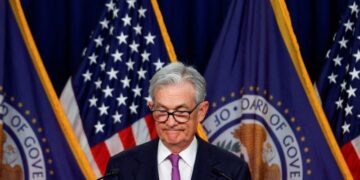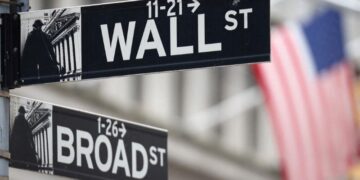The biggest bull in markets heading into 2025 has already gone back to the drawing board. But considering what’s happened to US stocks in the last two months, he’s as cheery as ever.
John Stoltzfus, the chief investment strategist at Oppenheimer, entered the year with a Street-high S&P 500 target of 7,100, which implied the index was primed for another 20% gain.
“We thought the innovation factor of technology, a more-friendly-to-business administration would justify that amount of upside,” Stoltzfus said in a recent interview with Business Insider.
Instead, US equities are flirting with bear market territory as investors sweat the implications of President Donald Trump’s risky new trade strategy for the economy and corporate earnings.
“When the tariffs were introduced, it all looked a lot harsher than we had expected,” Stoltzfus said, adding that he realized it was “highly unlikely” that the S&P 500 would hit his original mark.
By Stoltzfus’ own admission, stocks would do well to break even for the year. His new year-end S&P 500 target of 5,950 means that they’d have to leap 12% from here to eke out a 1% gain.
Even that more modest outlook could be out of reach if the US economy slips into a recession, but Stoltzfus is confident that won’t be the case. That’s not to say there won’t be growing pains.
“The problem is not so much where we’re headed, but as to getting over where we are now,” Stoltzfus said.
Recession calls will be wrong again
While some strategists seem certain that economic growth will contract, Stoltzfus is wary of taking their word for it. He was quick to note that such predictions have missed the mark, including a now-infamous forecast that had pegged the odds of a recession at 100%.
“It was the argument that brought down the markets into bear market territory in 2022, but the recession never happened,” Stoltzfus said. “Similarly, the recession argument didn’t work in ’23, it didn’t work in ’24 here because of the slowing of the economy.”
Current economic data seem to be on Stoltzfus’ side, as last month’s job additions and inflation were both far more encouraging than anticipated.
However, those backward-looking reports don’t account for Trump’s surprisingly high tariffs. More recent readings show that consumer sentiment is plunging, and consumer confidence is already weak. And while the first-quarter earnings season has brought some bright spots so far, it has also brought some alarming forecasts.
Consumers’ pessimism likely stems from persistent inflation, Stoltzfus said. And while prices are almost certain to rise further as tariffs take effect, the strategy chief thinks increased competition among places like restaurants and supermarkets will keep inflation in check.
As for profits, Stoltzfus expects S&P 500 firms to generate a mid-single-digit gain in aggregate, despite all the volatility on the policy and geopolitical fronts. However, investors should carefully choose high-quality companies that are more likely to post resilient earnings.
“All earnings are not derived from importation,” Stoltzfus said. “There are some earnings that are actually derived from services that are produced in this country, products that are produced in this country, and sales that are produced in this country.”
Markets are misreading Trump’s trade strategy
Besides being more bullish about stocks and the economy than most strategists, Stoltzfus also stands out for his support of the Trump administration’s plan to shake up the trade landscape.
The strategist thinks the oft-debated aim of Trump’s protectionist trade policy is to shift the global economy away from China — preferably to the US, but to other countries as well.
“We don’t think it’s an end of globalization,” Stoltzfus said. “We think the endpoint of this is just re-globalization with benefits for both developed and emerging markets outside of the US, to pick up some of the business that has been dedicated to China for so many years.”
Anti-globalism sentiment was present in Trump’s first term during the smaller, more targeted trade skirmish with China, though Stoltzfus noted that it got exacerbated during the pandemic.
“During the COVID period, it was recognized that — especially related to supply-chain items as well as healthcare, whether it was over-the-counter or pharmaceuticals — this was a problem to have all roads leading to China for a global supply chain,” Stoltzfus said.
China has been accused of unethical trade practices like corporate espionage, plus some military experts think they could cause global chaos by invading Taiwan in the coming years. That’s why politicians across party lines largely agree that the US should bring back industries that are critical to national defense and security, like semiconductors and healthcare products.
“We need to bring those home, but we don’t think the ultimate goal is likely to bring everything back,” Stoltzfus said.
If Trump can get the rest of the world to team up against China, his trade skirmish may succeed.
“When people work together, they can really accomplish more than if they battle with each other,” Stoltzfus said. “The problem is, where we are right now requires a negotiation process that is led into by discomfort of — I wouldn’t say a tariff war, but of the implications of a potential tariff war.”
Shop for stocks in sectors on sale
Like other bullish strategists, Stoltzfus is counting on a lot going right this year.
For the S&P 500 to reach his new forecast, it would likely require economic growth to persist and the trade dispute to be resolved amicably while earnings continue to rise.
And even if corporate profits rise to $265, the index would need to trade at a lofty 22.5x multiple — all just for the S&P 500 to make a roundtrip back to where it was at the start of the year.
As for how investors can ride this potential rebound, Stoltzfus said he’s sticking with growth-heavy groups like technology and consumer discretionary, which happen to be the two worst-performing sectors so far this year. His other outperform-rated sector is industrials.
“We like the stuff that has gotten beaten up,” Stoltzfus said.
Industrial firms will need to increase their tech investments, the strategist said, which could benefit both sectors. Plus, consumers tend to spend despite economic uncertainty, and even if growth slows, they’re likely to keep their subscriptions for streaming services.















